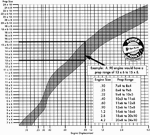dhk79
Well-known member
As promised in the selecting the "right" airfoil thread here is a corresponding write up on propeller selection. This is a subject I covered briefly in my physics tutorial (originally posted in 2007). Here I’ll dig a little bit deeper and provide more background.
Selecting the “right” propeller for a plane is probably the biggest factor in improving its performance. On the other hand, picking a “wrong” prop is best way to ensure you have a dog in the air.
Most R/C propeller manufactures have a chart or table matching the correct sized props to engines. APC, however, totally passes the selection off to the engine manufactures and does not make any recommendations for propeller use. Their disclaimer specifically refers to written instructions/recommendations that are provided with most motors and directs the consumer to contact the motor manufacture for suggestions.
Selecting the “right” propeller for a plane is probably the biggest factor in improving its performance. On the other hand, picking a “wrong” prop is best way to ensure you have a dog in the air.
Most R/C propeller manufactures have a chart or table matching the correct sized props to engines. APC, however, totally passes the selection off to the engine manufactures and does not make any recommendations for propeller use. Their disclaimer specifically refers to written instructions/recommendations that are provided with most motors and directs the consumer to contact the motor manufacture for suggestions.


